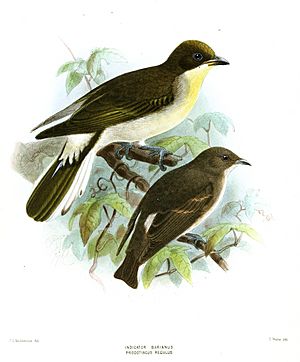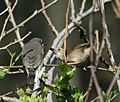Honeyguide facts for kids
Quick facts for kids Honeyguides |
|
|---|---|
 |
|
| Greater honeyguide and brown-backed honeybird |
|
| Scientific classification |
|
| Kingdom: | Animalia |
| Phylum: | Chordata |
| Class: | Aves |
| Order: | Piciformes |
| Infraorder: | Picides |
| Family: | Indicatoridae Swainson, 1837 |
| Genera | |
|
Indicator |
|
Honeyguides (family Indicatoridae) are near-passerine birds of the order Piciformes. They are also known as 'indicator birds', or 'honey birds'.
They have an Old World tropical distribution, with most species in Africa and two in Asia. These birds are known for their interaction with humans. One or two species will deliberately lead humans to bee colonies, so that they can feast on the grubs and beeswax that are left behind.
Brooding
The breeding behavior of eight species in Indicator and Prodotiscus is known. They are all brood parasites that lay an egg in a nest of another species. Most prefer hole-nesting species, often the related barbets and woodpeckers, but Prodotiscus parasitizes cup-nesters such as white-eyes and warblers. Honeyguide nestlings have been known to throw out their host's chicks from the nest. They have hooks on their beaks with which they puncture the hosts' eggs or kill the nestlings.
African honeyguide birds are known to lay their eggs in underground nests of other bee-eating bird species. The honeyguide chicks kill the hatchlings of the host using their needle-sharp beaks just after hatching, much as cuckoo hatchlings do. The honeyguide mother ensures her chick hatches first by internally incubating the egg for an extra day before laying it, so that it has a head start in development compared to the host.
Images for kids
See also
 In Spanish: Indicadores para niños
In Spanish: Indicadores para niños


